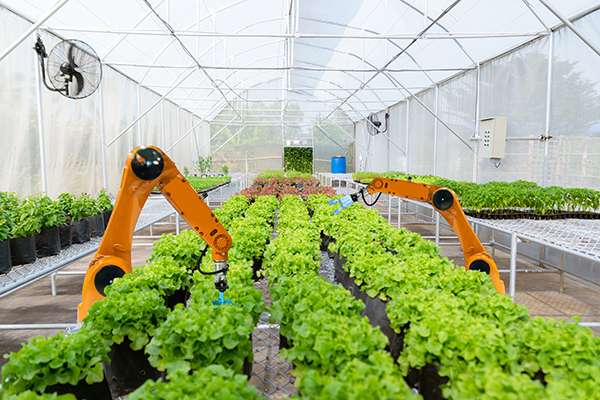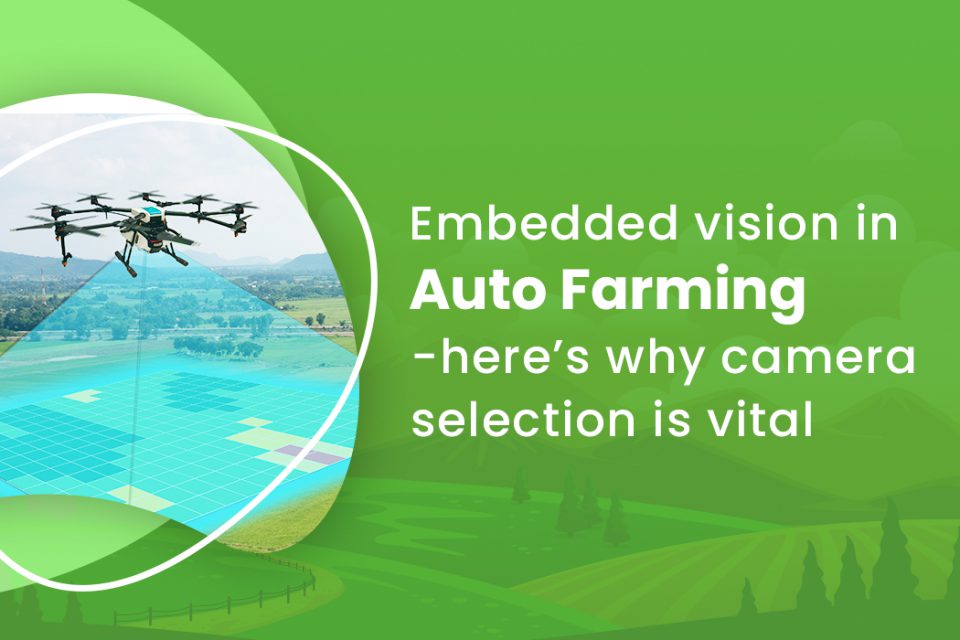Auto farming or agriculture automation is no longer a distant dream for an industry that has historically dealt with high labor costs, poor manual productivity, and siloed data. There are also constantly major problems concerning policy changes, weather volatility, and other environmental factors that could cause untold losses. It’s why AI-powered embedded vision has been such a boon to the modern agriculture industry.
Embedded vision and AI based applications have, after all, enabled agriculture businesses of all sizes to significantly cut down manual labor costs while accelerating the speed of operations. In addition, it has led to an unprecedented improvement in crop yields, which has increased profitability.
Today, the scope of embedded vision applications stretches as long as the horizon. Agricultural robots, drones, and large vehicles used for auto farming leverage camera based systems for the purposes of navigation, crop health assessment, pest detection, harvesting, planting, weed detection, watering, spreading fertilizer, etc.
Equipped with the right sensor, interface, processor, and ISP (Image Signal Processor), the camera acts as the eye – capturing high-quality images of crops and vegetation. Images obtained from these cameras are analyzed using computer vision and AI algorithms to identify patterns, check for anomalies or other requirements. The farmer gets access to real-time data about crops, the terrains, and weather patterns. It provides actionable insights that tremendously improve their decision-making capabilities.
Applications of embedded vision in auto farming
Before we look at why choosing a camera is vital to the performance and functioning of certain auto farming equipment’s, let us first learn some of the key camera based applications in auto farming.
Agricultural robots and vehicles
Agricultural robots come in a very wide range of sizes starting from a little more than a couple of feet in length to many meters long. They are used predominantly for the following tasks. The function of a camera in a task is also given against each of them.
- Picking and harvesting: here cameras help to identify the exact coordinates of fruits and vegetables, capture images for identifying ripeness, size, and type of the produce etc.
- Weed and bug detection: this involves detecting harmful weeds and bugs in order to precisely spread fertilizers. Cameras used in such robots need to deliver clear images even in challenging conditions for the AI algorithm to accurately detect weeds and bugs.
- Crop detection and assessment: this involves activities like measuring NDVI (Normalized Difference Vegetation Index) which is facilitated by cameras having NIR (near infrared) sensitivity.
- Watering and spreading fertilizer: based on the data collected on weeds, bugs, plants etc. agricultural robots are used to precisely water crops and spread fertilizers on them.
- Soil analysis: agricultural robots equipped with cameras also help in analyzing soil texture, water content, soil type, etc.

In agricultural robots and large vehicles, the key function of a camera is to capture sharp and clear images even when the robot is in motion under challenging lighting conditions. We will look at the major requirements of a camera used for agricultural applications in the key features section.
Agricultural drones
Drones used in agriculture perform similar tasks as robots with the key difference being their ability to cover a wide area leveraging aerial view. For instance, drones are popular for their multispectral imaging capabilities as they can cover tens of thousands of acres in a single day! They can be used to monitor granular details of crops, such as exact plant growth, vegetable color, field row spacing, flower count, etc.
Why camera selection is a crucial process in auto farming
Now that we have understood various agricultural applications where cameras are used, let us look at why camera selection and evaluation are critical to ensuring reliable performance of auto farming equipments.
Selecting the type of camera solution can be a grueling process. Remember that these applications operate in unpredictable outdoor environments where the lighting can vary without warning. Therefore, capturing high quality images is no easy task. These robots and equipments also come in large sizes which require the cameras to be installed at a large distance from the host processor. Furthermore, these applications need cutting-edge AI processors that are capable of running machine and deep learning algorithms for accurate data analysis.
Keeping these in mind, in the next section we will look at some of the key features required for cameras used in agricultural robots, vehicles, and drones. We will also talk about why each of these features is important for the reliable performance of such equipments.
Key features of cameras used in agriculture
Flexible cabling
Owing to their large size, agriculture robots and drones many a times need to have a camera system that can transmit image data to long distances from the host processor. In such cases, the choice of camera interface becomes critical. USB and MIPI – which are two of the most popular camera interfaces – are not suitable in such cases where the maximum distance to which they can transmit data is 3 meters. As an alternative, interfaces such as GMSL and FPD Link are recommended using which cameras can be installed at a distance of up to 15 meters from the host processor.
Shutter type and frame rate
Many agricultural robots have the entire robot or its arm in continuous motion. This may lead to motion blur or shutter artifacts in the captured images. To reduce motion blur, a high frame rate camera with low exposure time is recommended. To eliminate shutter artifacts, a global shutter camera would be better choice over a rolling shutter one.
In most of the agricultural applications involving a robot or drone in motion, a rolling shutter camera with high frame rate or low exposure time should do the job. A global shutter camera is typically recommended when a rolling shutter camera is unable to attain the desired image quality.
HDR (High Dynamic Range)
As mentioned earlier, auto farming applications are primarily used in outdoor locations. So, the camera has to cope with high-contrast lighting conditions. Also, these robots at times have to operate in night conditions (mostly with assisted lighting). This requires the camera to have high dynamic range (typically in excess of 90 dB) that enables accurate capture of images in bright as well as low lighting conditions. This feature also makes it possible to bring out accurate image details in both the brightest and darkest areas of the same scene.
Multi-camera synchronization and external trigger support
Whether a robot or drone is used for crop analysis, weed detection, or harvesting, most of the times a single camera cannot do the job. If the vehicle is large in size, typically a minimum of 3 cameras are required for 360 degree image capture. Hence the camera system should come with the capability of synchronous operation. Also, they need to have external trigger support for integrating with external sensors such as IMU, LiDAR, GPS, etc.
NIR sensitivity
Different types of crop analyses – such as NDVI measurement – require the auto farming equipment to have the ability to capture images in the NIR (near infrared) region. Such applications need to have a camera system which come with high quantum efficiency in the NIR spectrum.
Enclosures for use in harsh environments
As discussed before, agricultural robots and vehicles need to operate in harsh outdoor conditions. For a reliable long term functioning, the camera has to be protected from dust, water, and solids. In such cases, cameras with IP rated enclosures are recommended. The IP rating of the camera can be decided based on the environment and level of protection required. For complete protection, a rating of IP66 or above is recommended.
Why e-con Systems is your auto farming camera partner of choice
e-con Systems offers state-of-the-art embedded cameras to empower modern agriculture applications, whether to detect bugs/weeds, evaluate crop health, monitor seasonal growth, or simply automate your entire harvesting process. e-con’s wide portfolio includes cameras with features such as high dynamic range, global shutter, GMSL2 interface for long cable support, multi-camera synchronization, external trigger, NIR sensitivity, and IP rated enclosures.
Other pertinent features of e-con’s cameras include
- Lightweight, versatile, and optimized for power consumption
- Inbuilt image signal processor for auto exposure and auto white balance functions
- High signal to noise ratio for image output with less noise.
Below is a list of e-con cameras suitable for various agricultural applications:
- STURDeCAM25: IP67 Full HD GMSL2 global shutter color camera module
- See3CAM_CU27: Sony STARVIS IMX462 based ultra-low light USB camera with superior NIR performance
- See3CAM_CU81: 4K HDR USB camera based on the 1/2″ AR0821 sensor
- NileCAM21: Full HD GMSL2 HDR camera with LED flicker mitigation and 15 meter cable support
- See3CAM_CU22: Full HD HDR USB camera with LED flicker mitigation
- eCAM22_CUXVR: Sony STARVIS IMX327 based ultra-low light MIPI camera
e-con Systems also offers extensive customization services to ensure its cameras meet the specific requirements of your agricultural robots, vehicle, or drones. We can help you choose the right sensor, interface, optics, and processing platform to make sure your agricultural equipments meet the desired performance standards.
We have worked with numerous agritech customers where we helped them smoothly integrate our cameras into their device.
Looking for help in choosing the right camera for your auto farming device? Please write to camerasolutions@e-consystems.com. Our camera experts will be happy to help you.

Gomathi Sankar is a camera expert with 15+ years of experience in embedded product design, camera solutioning, and product development. In e-con Systems, he has built numerous camera solutions for robots, industrial handhelds, quality inspection systems, smart city applications, industrial safety systems, and more. He has played an integral part in helping hundreds of customers build their dream products by integrating the right vision technology into them.




